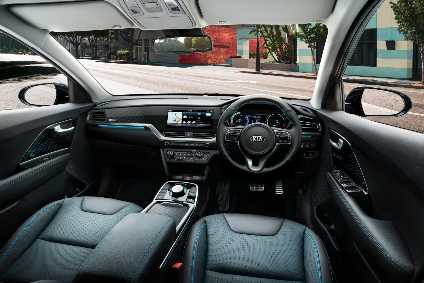|
Kia e-Niro’s feature-rich cabin cuts a dash |
Launched in 2018, the e-Niro is Kia’s second globally sold electric vehicle after the Soul EV. Continuing just-auto/AIC’s review of interior design and technology trends, we take a closer look inside this electric crossover.
It’s what’s inside that matters
Once seated in the purpose-built EV, the fascia and information clusters follow what is becoming a modern theme for the Korean brand, starting with a wide dashboard set out on horizontal lines.
The e-Niro currently comes in just one trim level, the ‘4’ which wants for nothing. The dash features bright blue trim around the air vents, echoing the trim highlights found on the car’s exterior. Glossy black and blue trim also line the doors. The shelf at the base of the dash features a wireless charger for smartphones.
Incorporated into the centre console are a rotary drive selector and buttons for the electronic parking brake, heated seats, heated steering wheel, drive mode select, parking sensors, and the car’s braking ‘Auto Hold’ function.
Material-wise, the areas of the cabin that you touch the most are swathed in soft-touch materials, while other parts are hard plastic set beneath a dark headliner. A leather-trimmed heated steering wheel, high-gloss black inserts hither and thither and satin chrome interior door handles add to the classy feel.
Elsewhere in the cabin, just about every last nook and cranny has been used for storing all your bits and bobs. Other thoughtful touches include an overhead sunglasses case.
Measuring 4,375mm long, the e-Niro slots between the Ceed hatchback and Sportage SUV in size. Its body is 1,805mm wide and 1,570mm tall providing plenty of head and shoulder room for front seat occupants.
One major difference with the e-Niro is that luggage capacity has been enhanced compared to its hybrid and PHEV counterparts, offering 451 litres of space with all five seats occupied. This compares to 382 litres on the Hybrid and 324 litres for the PHEV. The boot expands to 1,405 litres – up from the 1,380 litres of the Niro parallel hybrid and 1,322 of the PHEV – with the 60/40 split rear seats folded. The luggage area features an undertray for storing the recharging cables.
Connectivity
The e-Niro features the brand’s UVO Connect telematics system. UVO features the Kia Live system, housed within the 10.25-inch touchscreen in the centre of the dashboard. The system uses its own eSIM chip to retrieve and update live data during a drive, such as live traffic information, weather forecasts, points of interest, and details of potential on- and off-street parking – including price, location and parking availability.
The second element of the UVO system is an app, designed for compatibility on Android and Apple smartphones. The app offers users peace of mind with a range of features to provide diagnostic data about their car and the trips they take. It also enables drivers to check battery charging status remotely and send a route to the sat-nav in preparation for a journey.
Infotainment
The touchscreen navigation system looks good and brightens up the dark grey interior. It features Bluetooth as standard, enabling occupants to connect two mobile devices at once, as well as Apple CarPlay and Android Auto. Its split-screen functionality lets users control or monitor different vehicle features simultaneously, customising the screen with a series of different widgets. This enables the driver to select a single display (such as navigation or battery information) or combine elements on-screen at the same time. The driver can follow navigation directions or keep track of battery energy efficiency, while passengers can choose their favourite songs or check the weather forecast. The infotainment system also controls vehicle recharging preferences and ambient light settings. Perhaps best of all is an eight-speaker JBL Premium sound system with a 320-watt external amplifier that comes as standard.
Advanced air-con
Another neat trick of the e-Niro is its HVAC system. This has been adapted from that in the Soul EV, and allows only the driver’s side of the car to be cooled when the other seats are unoccupied to minimise energy usage. It does this through a smart air intake, in contrast to rival systems which merely divert the airflow towards the driver when other vents are closed and consequently do not reduce energy consumption.
Advanced driver assistance systems
Standard driver assistance technologies include forward collision avoidance assist with pedestrian and cyclist detection, adaptive smart cruise control, driver attention warning and lane keeping assist system.
Weightwatchers
Made up of 53 per cent advanced high-strength steel, e-Niro’s structure is particularly strong. It also has liberal doses of aluminium. Its bonnet, tailgate panel, front bumper back beam and several chassis elements, including the front knuckles, front lower arms and brake calipers are made of aluminium to further help reduce weight.
The lightweighting theme spreads into the interior as the front seats save 1.3kg each thanks to their high-strength steel frames. The shapely front seats are also space-saving with special foam-backed covers and slim headrests. A tyre mobility kit was found in the boot rather than a spare wheel, reducing weight yet further.
On the road
The e-Niro is equipped with a 64 kWh lithium-ion polymer battery pack, with a nippy feel around town and incredibly quick (in ‘sport’ mode) on the open road. In a straight line, it will shift from a standstill to 60 mph in just over 7 seconds. Charging is pretty fast too. The battery can be recharged to around 80 per cent in just under an hour using a 100kW charger while a full charge takes about nine hours using a 7kW domestic wall box. On the combined cycle, it provides a driving range of 282 miles on a single charge.
Seat and mirror heaters were most welcome on some chilly December mornings although using those features nibble away at the driving range. We found the display and dials on the centre console to be intuitive and well set out. Mercifully, not everything is controlled via the touchscreen as some large, chunky dials to operate the HVAC are located lower down on the centre stack. All the switches feel nicely damped. The circular drive selector further adds to the car’s effortless driving feel. The net result is a cheap-to-run car loaded with the generous kit that we have come to expect from this carmaker.















